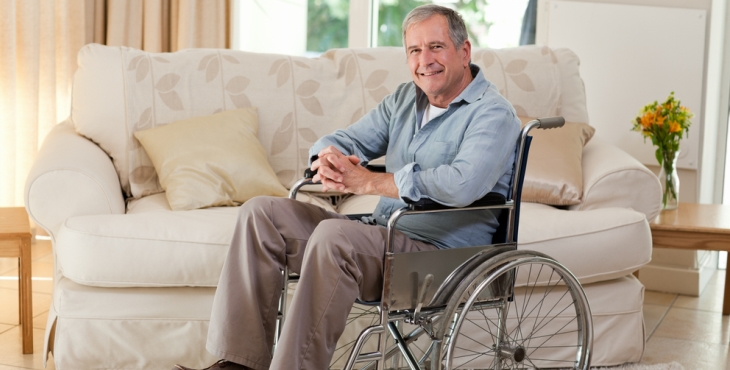For Veterans who need a more accessible living space, outfitting your home for walkers, wheelchairs, scooters and other assistive devices requires forethought and planning. But it doesn’t have to involve major renovation projects or big budgets. Here are some fixes you, your family or a helpful handyman can do to help make your home safer to get around.
- Take a look throughout your entire home. Where do you see the potential for falls, slips, trips or getting stuck? Enlist some help to remove these hazards.
- Remove all throw rugs and mats. These items can cause slips and falls, and walkers, canes and wheelchairs are apt to catch on them.
- Replace all door units and trim door frames if they aren’t wide enough to fit a wheelchair or walker through comfortably. You can also swap regular door hinges with expandable offset door hinges. These are designed to swing the door clear of the opening, which adds about two extra inches to the doorframe. You can buy these hinges at hardware stores or order them online.
- Install a ramp. Different length ramps are available at many hardware stores and online. They are portable or easy to install.
- Bring items closer to your level. High cabinets are hard to reach, even with mechanical reachers. Move everyday items, such as dishes and utensils in the kitchen or towels and toiletries in the bathroom, to lower-level cabinets. Or put everyday items in bins with handles. This way, you can pick them up and place them on your lap.
- Consider bed cables. Install cables at the foot of your bed. You can use them to lift to a sitting position, or to help swing your legs over the edge of the bed.
- Invest in a lift chair. Lift chairs are reasonably priced, and they can help you stand at the click of a switch. Be careful, though, and make sure someone is there to help in case it takes a moment for you to gain your balance.
The bathroom, a place where water meets tiled floors and ceramic tubs, can be highly dangerous, especially for people with mobility concerns. Here are a few easy fixes to prevent slips and falls.
- Place grab bars strategically to help you move around. While there are suction cup grab bars, consider hiring a professional to install permanent bars to be sure they’re well affixed in studs. Have the bars placed wherever they’ll be convenient to support you and your needs.
- Place a shower chair in your shower or bathtub. Or use it to straddle the outer rim of the tub, allowing you to slide across the seat into the tub or shower. Make sure that the chair legs raise the bench so that it doesn’t rock on the edge of the tub, which can make it unstable.
- Purchase a raised toilet seat with or without handrails. These are typically easy to install. Invest in a portable seat to use when you’re traveling. You can also leave a standing commode at your bedside for nighttime use.
- Replace faucets with single lever controls, which are easier to turn, allowing you to better maintain balance. Make sure your water heater is set low enough to prevent scalding if you cannot turn the controls easily.
- Buy hand-held shower heads to make it easier to shower while sitting. You can easily add these inexpensive replacements to many existing showers.
Something as simple as getting in and out of the car can seem like a monumental task when you have trouble getting around. These simple add-ons can make it easier.
- Try a swivel seat. These seats allow the driver or passenger to turn their body easily when entering or exiting the car.
- Attach a removable bar to the door latch of the car. This provides a solid grip for you to hold on to.
- Fasten assist handles to the upper window frame of the car door as an alternative to a removable bar. Note that you’ll need to remove these handles when closing the window completely.
You may be able to make your house and car comfortable and accessible without a complete overhaul. These simple tweaks can help make your home safer too.
About the author: Nancy Kupka, Ph.D., R.N., is the daughter of a WWII cavalry officer and a Korean War nurse. Although it is intended to be accurate, neither Walgreen Co., its subsidiaries or affiliates, nor any other party assumes for loss or damage due to reliance on this material. Walgreens does not recommend or endorse any products, opinions, or other information that may be mentioned in the article. Reliance on any information provided by this article is solely at your own risk.
Topics in this story
More Stories
Summer can be a joyful time of year, but some outdoor activities can be hard for some Veterans. In this guest post, former VA Secretary Bob McDonald shares resources and plans to navigate summer activities.
"A CAPITOL FOURTH" airs on PBS Thursday, July 4, 2024 from 8:00 to 9:30 p.m. E.T.
The following is an account from Army Veteran Robert Pryor on how he was able to find and reconnect with the pilot who saved his life in Vietnam.







There is a new bed mobility system to help those with problems of getting in/out of bed (or repositioning in bed). Even has an option that allows safe/independent bed transfers for many with no leg strength. Check out http://www.FriendlyBeds.com.
I need to know what it will take to find a way to get upstairs or get down stairs. I have been falling lately for about 3 weeks now and it coming more often.
How about more information on the bed straps? I can’t find them anywhere.
I can’t stress how buying a good quality raised toilet seat improves safety in the bathroom. The toilet in my Grandmother’s house literally came loose from her falling onto the toilet seat. My Dad and I rode down to the hardware store and bought a raised toilet seat with hand rails. My Grandmother say’s it’s the ugliest toilet seat she’s ever seen but loves how easy it is to get up and down from. I love how may Grandma still has here sense of style!